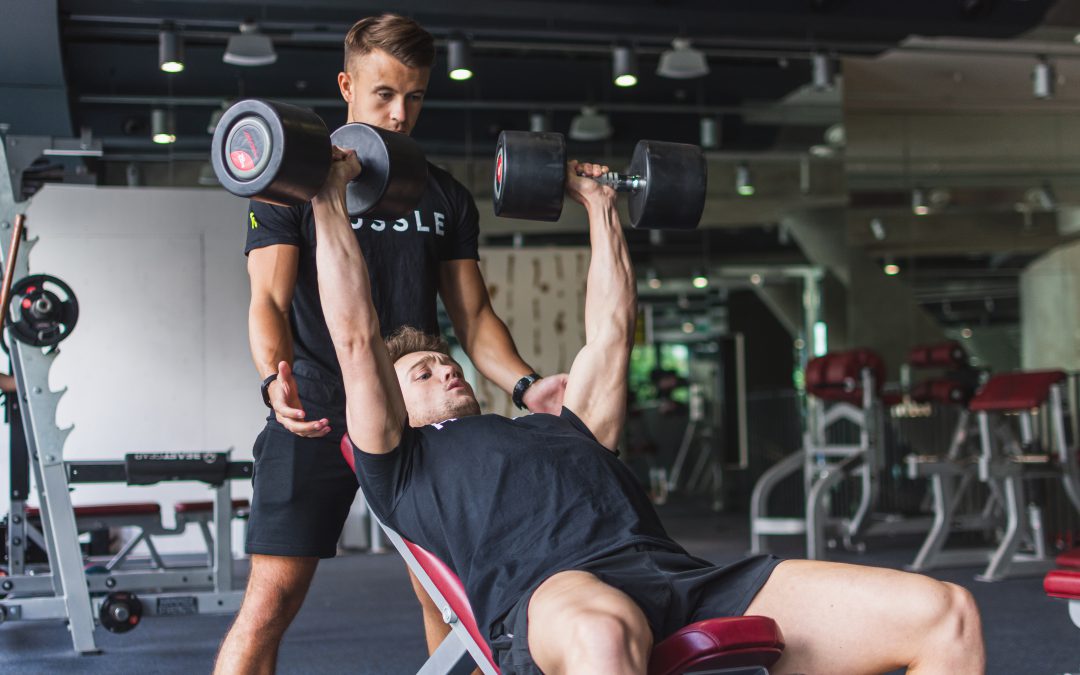Love training with a friend? Us too. Going to the gym with a workout buddy is fun, motivating, and makes the whole experience better. But what should you do when your training partner wants to lift heavier weights?
Experienced gym goers know all about “spotting” – the art of safely supporting someone’s lift (without getting intrusive). Want to learn how? Get ready to unlock this next-level lifting skill.
What is spotting?
“Need a spot?” “Spot me, bro.” “Your bar, your bar!” If these phrases sound like a foreign language, you’re in the right place. We’re about to bring you up to speed with the advanced gym skill called “spotting”
Exactly what is spotting? It’s definitely not just helping your partner put their bar back in the rack. Nor is it a sneaky way for them to add a few kgs to their lift.
Done properly (like we’re about to teach you), spotting is about helping another lifter increase their lifts – super safely.
Why is spotting important?
What’s the fundamental rule of gym training? Progressive overload. If you want to make progress, you need to keep pushing. And in the weights area, this means more reps and more weight.
But there’s one obvious problem. How can you push to the edge of your comfort zone and keep things safe?
The whole concept of lifting “to failure” means that you need to push things to that zone where you might not be able to finish your final rep. The struggle zone. The range of “yep, that’s definitely my max!”
Enter: your spotter. When you have a spotter, you can push past your comfort zone and enter the realm of failing a lift. Because there will be someone to help you. Nothing can go wrong. You’ll be free to push to Gainsville with total confidence.
When should you spot someone?
You know those gym bros who spot each other on every single set of bench press? Yeah, don’t be those guys. As we’ve explained, you only need a spot when you’re pushing past your comfort zone.
Here are 5 times you might spot someone (or ask for a spot)
- When going for a 1-3 rep max
- When trying a weight you’ve never done before
- When fatigued after a few heavy sets
- When you have pre-exhausted the working muscle
- When you need help un-racking or re-racking the bar
And when should you not spot someone!
Like all good things in life, spotting needs consent. Never, ever rush over and grab someone’s bar if they haven’t asked you to. The one exception to this rule is if you hear someone shout “spot!”
The relationship between lifter and spotter is a beautiful thing. It takes trust, communication, and the ability to read body language. Some people don’t mind their spotter’s fingers on their bar throughout the lift. Others want to be left alone until the last second.
Things to discuss with your spotter before you start your set.
- Do you want the bar handed out to you?
- How do you like to be spotted?
- How will you communicate that you want them to touch your bar?
- Will you want help re-racking the bar?
Now you know how to talk about spotting, let’s look at the specifics of spotting different lifts.
How to spot on bench press
Let the lifter get settled on the bench. Position yourself behind their bar. Some lifting benches will have a small raised platform for spotters (to give you the extra height you need). You might like to stand on a bumper plate.
Check that your lifter is ready to start. Let them place their hands on the bar. Walk forward and take their bar with an underhand grip. Lift the bar out until it’s in position, say “your bar”, take your hands away and step back.
As they get close to failure (or their final few reps), step forward so you are in a good position to react. Place your hands under (but not on) their bar so you can take it if they fail the lift.
Once they have locked out their final rep, take the bar and guide it back into the rack.
Fist bump your lifting partner and congratulate them on a great set.
How to spot on seated shoulder press
To spot a barbell shoulder press, you will need to make sure you’re high enough to assist when the bar is over the lifter’s head.
If someone fails an overhead press, the bar will fall on their head: no bueno! Your main job as a spotter on this lift is guiding the bar back into the rack at the end of the lift.
If your partner is using dumbbells to do their seated shoulder press, gently assist them by placing your fingers under their elbows. If they give you the signal, you can give them a little push.
How to spot on lying triceps extension
Barbell triceps exercises can quickly get heavy. Your job as a spotter is to keep a close eye on the lifter so you can grab their bar if they fail the rep.
Stand behind the lifter, and pass the bar to them (as explained in the bench press). Then step back and let them get on with their reps.
When they reach their final rep – or if they call out for a spot before then – step forward and take the bar from them. Don’t wait for them to lock out the rep. When your triceps fail, you won’t be able to finish the rep!
How to spot on barbell squat
Experienced lifters know how to “dump” the bar off their back if they fail a squat rep. But that’s an advanced skill. And most gyms aren’t keen on barbells crashing and bouncing around.
Learn to spot each other on barbell squats and you can take your leg gains to infinity and beyond.
Let the lifter set up (stepping under the bar, positioning their hands on the barbell). Stand behind them, but not too close. Remember, they still need to unrack the bar and walk out. You don’t want to get in their way.
They will unrack the bar by taking three steps back. Get yourself in prime spotting position by standing right behind them. Spotting a squat is different to other lifts. This time, you won’t be touching the barbell to help your pal. You’ll be touching them. So you need to be close enough to get your arms around their torso.
The lifter will have their back to you during a squat, so that ninja-level training partner communication needs to be next level. Pay close attention to their breathing and body language. As soon as they start to struggle, get close and extend your arms so you’re ready to lend your body weight.
If they fail a rep during the squat, put your arms either side of their chest and use your own strength to help them stand back up.
If they’ve successfully finished their rep, but need help walking the bar back into the rack, just put your hands on the bar and guide it back in.
Other smart ways to support someone in the gym
Spotting isn’t the only skill you need to be an A1 training partner! Here are three other ways you can help your buddy reach their goals.
Timing your buddy’s reps
Pop quiz: which training variable starts with “T”? If you said tempo, have a gold star from the Arnold Schwarzenegger School of Gains (not a real place FYI).
Tempo is one of the key training variables you’ll find in any good lifting programme. By manipulating the speed at which you lift and lower your weights, you place the muscles under more tension. Time under tension = more muscle growth.
The thing about tempo is that it’s tricky to stick to. 2 seconds in real time feels like 30 seconds when you’ve got a bar on your back.
Why not help your training partner stick to their training programme by counting their tempo?
Monitoring their lifting form
Giving someone feedback on their lifting form might be frowned upon on Insta, but in the gym it’s downright helpful. Especially when the person you’re advising has asked you to help.
Give your training partner a boost by videoing their form on key lifts, or simple helping them with simple advice.
Motivating your training partner
What’s the best thing about training with someone? The energy! Be a better training partner by motivating your buddy when they’re going for a big lift. Pick them up when they seem a little low. Be their hype man when they’re down on themselves.
Learn how your training partner likes to be motivated. Before a lift, or during? Do they like noise, or gentle encouragement?
You know they’d do it for you! Together you’ll make more progress than going it alone.
Send this to your training partner before you plan your next workout! And if you’re looking for workouts to try together, check out this post.




